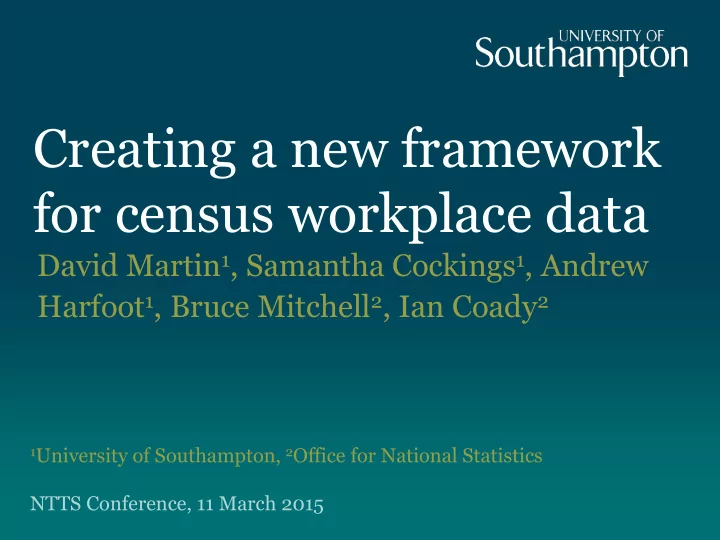

Creating a new framework for census workplace data David Martin 1 , Samantha Cockings 1 , Andrew Harfoot 1 , Bruce Mitchell 2 , Ian Coady 2 1 University of Southampton, 2 Office for National Statistics NTTS Conference, 11 March 2015
Presentation overview • 2001 and 2011 census output areas/automated zone design • Residential vs workplace populations • Creating 2011 census workplace zones and workplace data • National classification of workplace zones
Census output areas • Census output areas (England, Wales, Northern Ireland) designed to reflect residential locations • Automated zone design procedure first used for output area creation in 2001, then again in 2011 • Building blocks representing smallest postcodes built from Thiessen polygons and boundary data around addresses • Iterative recombination of building blocks and evaluation against objective functions, retaining best combinations – Population thresholds and targets, compactness statistics, intra-area correlations 3
4 Photos: David Martin
Why worry about non-residential population? • Understanding workplace population patterns is of particular relevance where population “exposure” is concerned: e.g. delivery of daytime services, transport planning or emergency planning • Distribution of workplace population/ workplaces is very different • Extraction of different population bases from place of residence and place of work statistics – usual residents, workplace population and “daytime” population • Only four workplace tables produced for 2011 output areas, NOT e.g. mode of travel to work, industry classification 5
2001 OA workplace population totals (mean residential population 300) 160000 120.00% 140000 100.00% 120000 80.00% 100000 Frequency 80000 60.00% Frequency Cumulative % 60000 40.00% 40000 20.00% 20000 0 0.00% Workplace population
Basic logic for workplace zones • Some output areas have very large workplace populations and can be subdivided into two or more workplace zones • Some are suitably sized and can also be workplace zones • Some have very small workplace populations and need to be combined with others to create a workplace zone • This can be set up as an automated zone design problem and implemented using procedures very similar to those used for output areas • Control over size allows much more workplace data to be published: 25 tables at workplace zone level
Workplace zone design • Workplaces need to be protected from disclosure risk: – 3 or more postcodes and 200 or more workers – homogeneity based on industry type – spatial compactness • Boundaries for subdivision built from postcode Thiessen polygons and map features (not individual workplaces) • 53,578 workplace zones of which 30.9% from subdivision (over 625 workers); 4.5% matched output areas; 62% from mergers (below 200 workers); 2.9% complex
Classification of workplace zones: the concept • Classify workplace zones according to key characteristics as measured by 2011 Census • Same concept as geodemographic classification of output areas, but for workplaces and workplace populations • Adopt similar method: – definition of dimensions; selection, transformation and standardization of variables; hierarchical k-means clustering; interpretation and naming of clusters
Workplace zone classification 11
Data and methods • 504 initial candidate variables; 63 chosen for further examination; 48 in final selection; particular attention paid to patterns of between-variable correlation • Box-Cox transformation and range standardisation applied before K-means clustering • Development of a 2-tier hierarchy; supergroups divided into groups (currently being processed) • Multiple diagnostic approaches to evaluation of clusters
Correlations
Transformations
Evolution of clusters…
7-cluster solution: highly qualified city Higher workers managerial Travel IT / finance / > 20km professional 5,183 workplace Pub trans zones High density / split OAs Young females + Black / Asian Employees - White British Highly qual, EU origin Photo: David Martin
7-cluster solution: rural occupations 10,858 workplace Work from home / no fixed place zones Mining & Quarrying / Manuf / Utilities / Low pub trans Construction V low density Low female Agriculture, Elderly workers Forestry, Self White Fishing employed British Photo: David Martin
Creating a National Statistics product • Workplace zones and data published for England and Wales • Workplace zones now being constructed for Scotland and Northern Ireland • Classification design based on England and Wales data: detailed subdivision of 7 groups being evaluated • Finally, roll-out of UK-wide classification of workplace zones
Recommend
More recommend